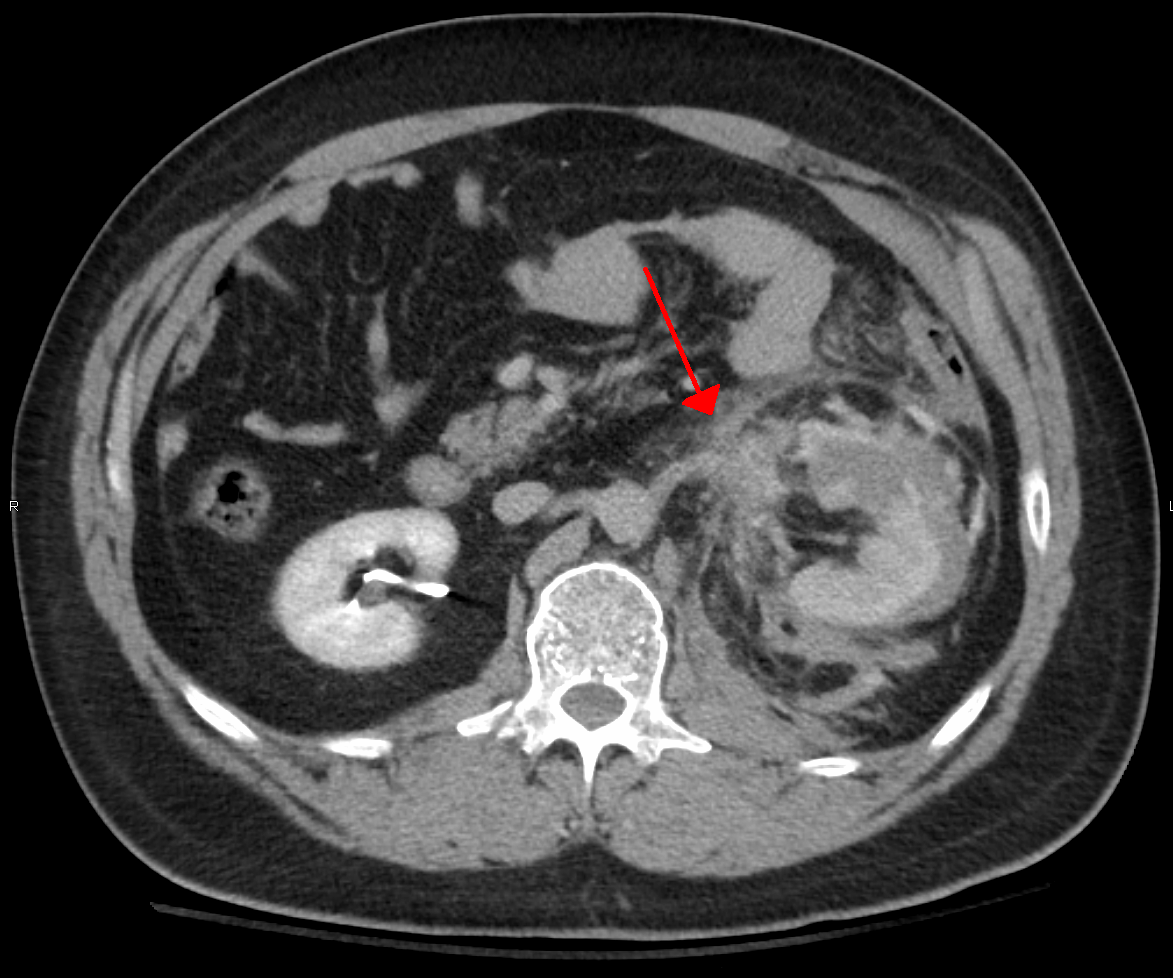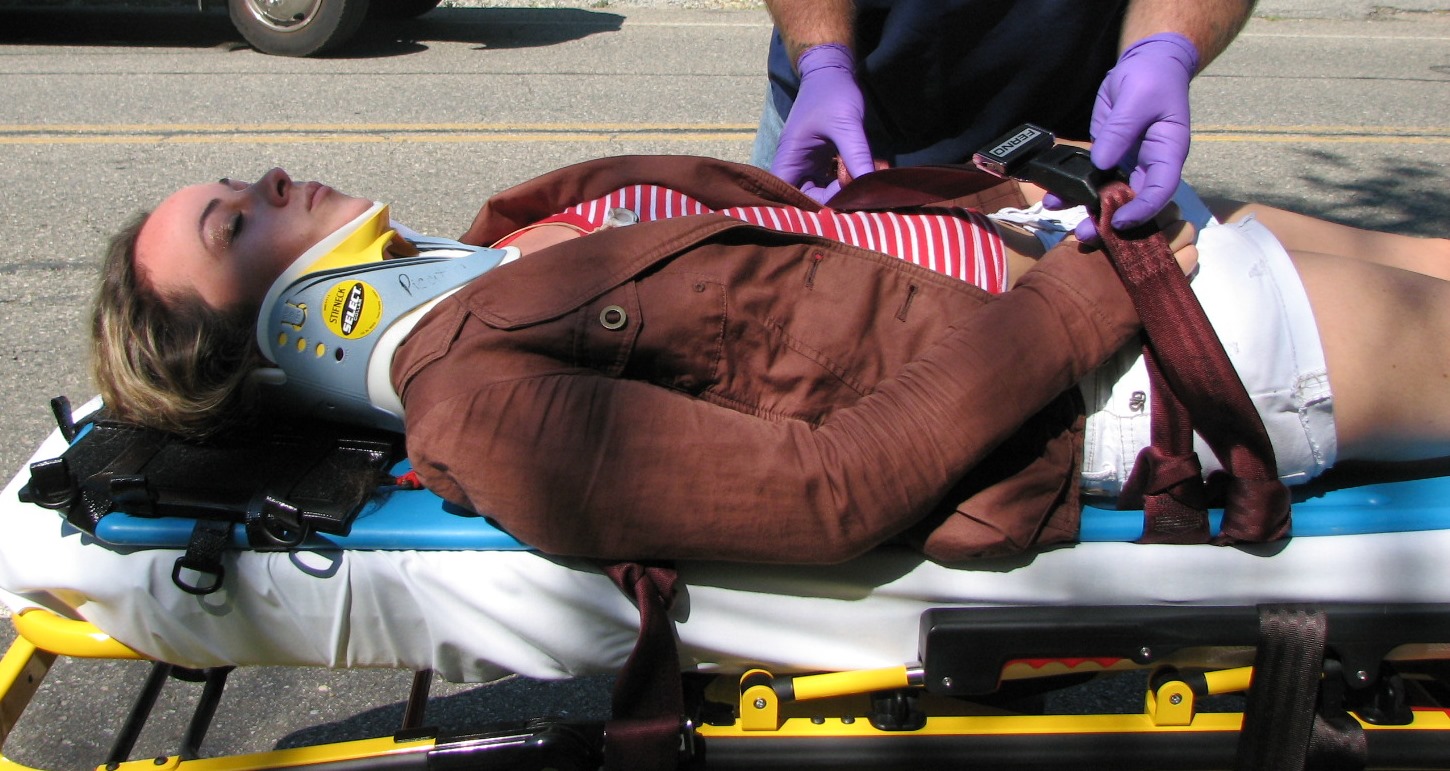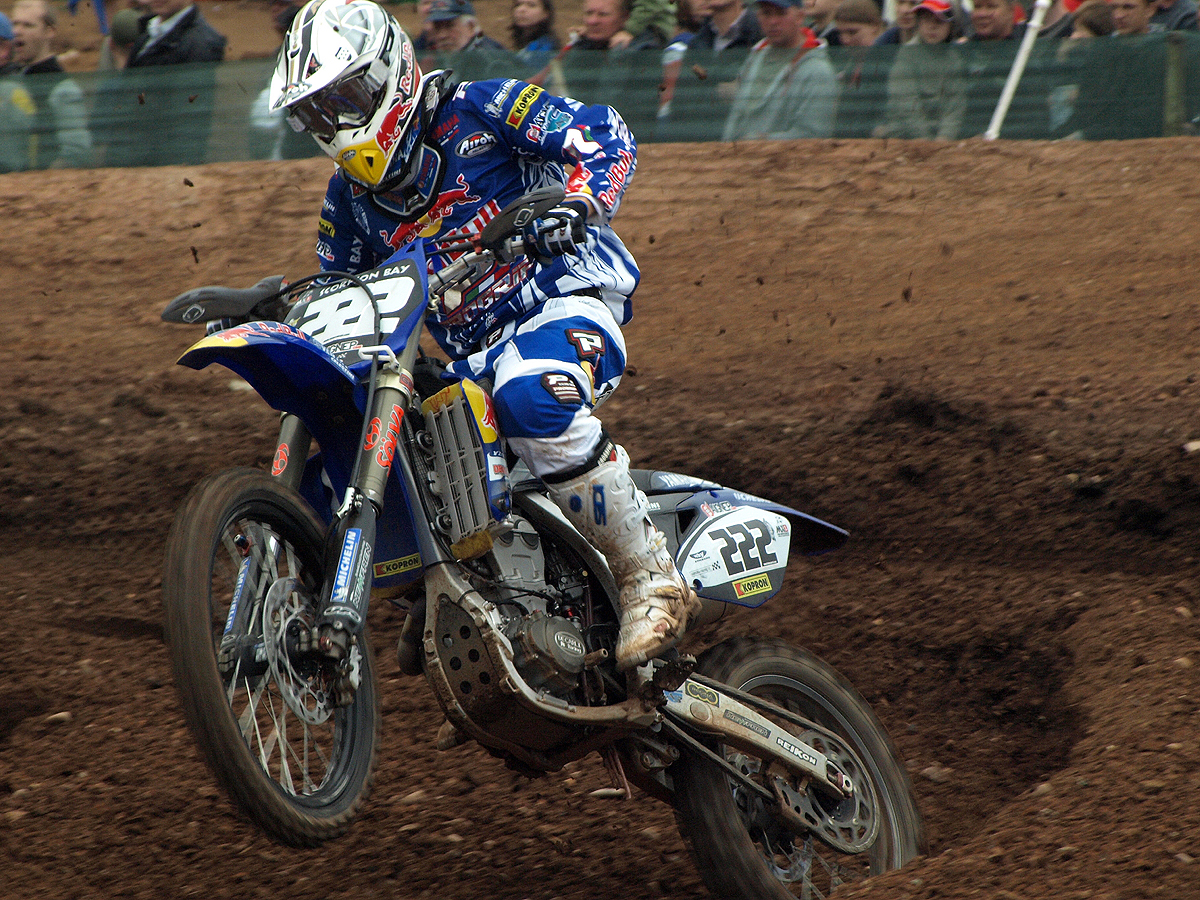|
Spinal Immobilization
Spinal precautions, also known as spinal immobilization and spinal motion restriction, are efforts to prevent movement of the spine in those with a risk of a spine injury. This is done as an effort to prevent injury to the spinal cord. It is estimated that 2% of people with blunt trauma will have a spine injury. Uses Spinal immobilization was historically used routinely for people who had experienced physical trauma. There is; however, little evidence for its routine use. Long spine boards are often used in the prehospital environment as part of spinal immobilization. Due to concerns of side effects the National Association of EMS Physicians and the American College of Surgeons recommend its use only in those at high risk. This includes: those with blunt trauma who have a decreased level of consciousness, pain or tenderness in the spine, those with numbness or weakness believed to be due to a spinal injury, and those with a significant trauma mechanism that are intoxicated or ... [...More Info...] [...Related Items...] OR: [Wikipedia] [Google] [Baidu] |
Spinal Cord Injury
A spinal cord injury (SCI) is damage to the spinal cord that causes temporary or permanent changes in its function. Symptoms may include loss of muscle function, sensation, or autonomic function in the parts of the body served by the spinal cord below the level of the injury. Injury can occur at any level of the spinal cord and can be ''complete'', with a total loss of sensation and muscle function at lower sacral segments, or ''incomplete'', meaning some nervous signals are able to travel past the injured area of the cord up to the Sacral S4-5 spinal cord segments. Depending on the location and severity of damage, the symptoms vary, from numbness to paralysis, including bowel or bladder incontinence. Long term outcomes also range widely, from full recovery to permanent tetraplegia (also called quadriplegia) or paraplegia. Complications can include muscle atrophy, loss of voluntary motor control, spasticity, pressure sores, infections, and breathing problems. In the major ... [...More Info...] [...Related Items...] OR: [Wikipedia] [Google] [Baidu] |
Spinal Cord
The spinal cord is a long, thin, tubular structure made up of nervous tissue, which extends from the medulla oblongata in the brainstem to the lumbar region of the vertebral column (backbone). The backbone encloses the central canal of the spinal cord, which contains cerebrospinal fluid. The brain and spinal cord together make up the central nervous system (CNS). In humans, the spinal cord begins at the occipital bone, passing through the foramen magnum and then enters the spinal canal at the beginning of the cervical vertebrae. The spinal cord extends down to between the first and second lumbar vertebrae, where it ends. The enclosing bony vertebral column protects the relatively shorter spinal cord. It is around long in adult men and around long in adult women. The diameter of the spinal cord ranges from in the cervical and lumbar regions to in the thoracic area. The spinal cord functions primarily in the transmission of nerve signals from the motor cortex to the ... [...More Info...] [...Related Items...] OR: [Wikipedia] [Google] [Baidu] |
Blunt Trauma
Blunt trauma, also known as blunt force trauma or non-penetrating trauma, is physical traumas, and particularly in the elderly who fall. It is contrasted with penetrating trauma which occurs when an object pierces the skin and enters a tissue of the body, creating an open wound and bruise. Blunt trauma can result in contusions, abrasions, lacerations, internal hemorrhages, bone fractures, as well as death. Blunt trauma represents a significant cause of disability and death in people under the age of 35 years worldwide. Classification Blunt abdominal trauma Blunt abdominal trauma (BAT) represents 75% of all blunt trauma and is the most common example of this injury. 75% of BAT occurs in motor vehicle crashes, in which rapid deceleration may propel the driver into the steering wheel, dashboard, or seatbelt, causing contusions in less serious cases, or rupture of internal organs from briefly increased intraluminal pressure in the more serious, depending on the force ... [...More Info...] [...Related Items...] OR: [Wikipedia] [Google] [Baidu] |
Long Spine Board
A spinal board, is a patient handling device used primarily in pre-hospital trauma care. It is designed to provide rigid support during movement of a person with suspected spinal or limb injuries. They are most commonly used by ambulance staff, as well as lifeguards and ski patrollers. Historically, backboards were also used in an attempt to "improve the posture" of young people, especially girls. Due to lack of evidence to support long-term use, the practice of keeping people on long boards for prolonged periods of time is decreasing. Extraction uses The spinal backboard was originally designed as a device to remove people from a vehicle. After a time people were simply kept on the spine board for transport without evidence supporting this need. Medical uses A spinal board is primarily indicated for judicious use to transport people who may have had a spinal injury, usually due to the mechanism of injury, and the attending team are not able to rule out a spinal injury. The p ... [...More Info...] [...Related Items...] OR: [Wikipedia] [Google] [Baidu] |
American College Of Surgeons
The American College of Surgeons is an educational association of surgeons created in 1913.American College of Surgeons Online "What is the American College of Surgeons?"/ref> See also *American College of Physicians The American College of Physicians (ACP) is a national organization of internists, who specialize in the diagnosis, treatment, and care of adults.Sokanu "What is an Internist?" Retrieved October 20, 2014 With 161,000 members, ACP is the largest ... References External links *ACS Foundation [...More Info...] [...Related Items...] OR: [Wikipedia] [Google] [Baidu] |
Decreased Level Of Consciousness
An altered level of consciousness is any measure of arousal other than normal. Level of consciousness (LOC) is a measurement of a person's arousability and responsiveness to stimuli from the environment. A mildly depressed level of consciousness or alertness may be classed as lethargy; someone in this state can be aroused with little difficulty. People who are obtunded have a more depressed level of consciousness and cannot be fully aroused. Those who are not able to be aroused from a sleep-like state are said to be stuporous. Coma is the inability to make any purposeful response. Scales such as the Glasgow coma scale have been designed to measure the level of consciousness. An altered level of consciousness can result from a variety of factors, including alterations in the chemical environment of the brain (e.g. exposure to poisons or intoxicants), insufficient oxygen or blood flow in the brain, and excessive pressure within the skull. Prolonged unconsciousness is ... [...More Info...] [...Related Items...] OR: [Wikipedia] [Google] [Baidu] |
Hard Cervical Collar
A cervical collar, also known as a neck brace, is a medical device used to support and immobilize a person's neck. It is also applied by emergency personnel to those who have had traumatic head or neck injuries, and can be used to treat chronic medical conditions. Whenever people have a traumatic head or neck injury, they may have a cervical fracture. This makes them at high risk for spinal cord injury, which could be exacerbated by movement of the person and could lead to paralysis or death. A common scenario for this injury would be a person suspected of having whiplash because of a car accident. In order to prevent further injury, such people may have a collar placed by medical professionals until X-rays can be taken to determine if a cervical spine fracture exists. Medical professionals will often use the NEXUS criteria and/or the Canadian C-spine rules to clear a cervical collar and determine the need for imaging. The cervical collar only stabilizes the top seven vertebra ... [...More Info...] [...Related Items...] OR: [Wikipedia] [Google] [Baidu] |
Intubation
Intubation (sometimes entubation) is a medical procedure involving the insertion of a tube into the body. Patients are generally anesthetized beforehand. Examples include tracheal intubation, and the balloon tamponade with a Sengstaken-Blakemore tube (a tube into the gastrointestinal tract). Examples * Catheterization * Nasogastric intubation * Tracheal intubation Tracheal intubation, usually simply referred to as intubation, is the placement of a flexible plastic tube into the trachea (windpipe) to maintain an open airway or to serve as a conduit through which to administer certain drugs. It is frequentl ... References Airway management Emergency medical procedures Medical equipment Routes of administration {{surgery-stub ... [...More Info...] [...Related Items...] OR: [Wikipedia] [Google] [Baidu] |
The Canadian C-spine Rule For Those With A Normal Glasgow Coma Scale And Who Are Otherwise Stable
''The'' () is a grammatical article in English, denoting persons or things already mentioned, under discussion, implied or otherwise presumed familiar to listeners, readers, or speakers. It is the definite article in English. ''The'' is the most frequently used word in the English language; studies and analyses of texts have found it to account for seven percent of all printed English-language words. It is derived from gendered articles in Old English which combined in Middle English and now has a single form used with pronouns of any gender. The word can be used with both singular and plural nouns, and with a noun that starts with any letter. This is different from many other languages, which have different forms of the definite article for different genders or numbers. Pronunciation In most dialects, "the" is pronounced as (with the voiced dental fricative followed by a schwa) when followed by a consonant sound, and as (homophone of pronoun ''thee'') when followed by a ... [...More Info...] [...Related Items...] OR: [Wikipedia] [Google] [Baidu] |
Canadian C-spine Rule
Clearing the cervical spine is the process by which medical professionals determine whether cervical spine injuries exist, mainly regarding cervical fracture. It is generally performed in cases of major trauma. This process can take place in the emergency department or in the field by appropriately trained EMS personnel. If the patient is obtunded, i.e. has a head injury with altered sensorium, is intoxicated, or has been given potent analgesics, the cervical spine must remain immobilized until a clinical examination becomes possible. Neurosurgeons or orthopaedic surgeons manage any detected injury. Today, most large centers have spine surgery specialists, that have trained in this field after their orthopedic or neurosurgical residency. History and examination A medical history and physical examination can be sufficient in clearing the cervical spine. Notable clinical prediction rules to determine which patients need medical imaging are the Canadian C-spine rule and the Nati ... [...More Info...] [...Related Items...] OR: [Wikipedia] [Google] [Baidu] |
Pressure Ulcer
Pressure ulcers, also known as pressure sores, bed sores or pressure injuries, are localised damage to the skin and/or underlying tissue that usually occur over a bony prominence as a result of usually long-term pressure, or pressure in combination with shear or friction. The most common sites are the skin overlying the sacrum, coccyx, heels, and hips, though other sites can be affected, such as the elbows, knees, ankles, back of shoulders, or the back of the cranium. Pressure ulcers occur due to pressure applied to soft tissue resulting in completely or partially obstructed blood flow to the soft tissue. Shear is also a cause, as it can pull on blood vessels that feed the skin. Pressure ulcers most commonly develop in individuals who are not moving about, such as those who are on chronic bedrest or consistently use a wheelchair. It is widely believed that other factors can influence the tolerance of skin for pressure and shear, thereby increasing the risk of pressure ulcer ... [...More Info...] [...Related Items...] OR: [Wikipedia] [Google] [Baidu] |
Cervical Collar
A cervical collar, also known as a neck brace, is a medical device used to support and immobilize a person's neck. It is also applied by emergency personnel to those who have had traumatic head or neck injuries, and can be used to treat chronic medical conditions. Whenever people have a traumatic head or neck injury, they may have a cervical fracture. This makes them at high risk for spinal cord injury, which could be exacerbated by movement of the person and could lead to paralysis or death. A common scenario for this injury would be a person suspected of having whiplash because of a car accident. In order to prevent further injury, such people may have a collar placed by medical professionals until X-rays can be taken to determine if a cervical spine fracture exists. Medical professionals will often use the NEXUS criteria and/or the Canadian C-spine rules to clear a cervical collar and determine the need for imaging. The cervical collar only stabilizes the top seven verte ... [...More Info...] [...Related Items...] OR: [Wikipedia] [Google] [Baidu] |





.png)

